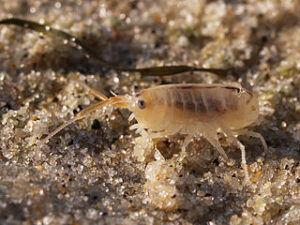It’s Summer and the California beaches are the vacation destinations of millions of people. It’s where we have fun in the sun, cool off in the water and relax on the sand under colorful umbrellas with cool drinks an d our favorite books.
d our favorite books.
Reality check: what we often find are crowds, screaming kids, sand in awkward places, sunburn, packed parking lots, traffic jams, and “Bugs”!
 Be prepared to share your summer beach experience with these annoying, “Beach Bugs”.
Be prepared to share your summer beach experience with these annoying, “Beach Bugs”.
Sand Fleas:
 The common sand flea (Orchestia agilis), that is found on California beaches, is really an amphipod, or a small, shrimp-like crustacean. They burrow into the sand and they feed on decaying plant and animal matter that washes up on the shore, especially seaweed. They do not want anything to do with people. They obviously are not fleas, not even insects. However, they jump, similar to the way fleas do and they live in the sand, so hence the name sand flea. On other beaches, around the world, different species of sand fleas present problems for humans, and other mamals, as they bite to gather blood in order to reproduce and carry diseases, not unlike mosquitoes.
The common sand flea (Orchestia agilis), that is found on California beaches, is really an amphipod, or a small, shrimp-like crustacean. They burrow into the sand and they feed on decaying plant and animal matter that washes up on the shore, especially seaweed. They do not want anything to do with people. They obviously are not fleas, not even insects. However, they jump, similar to the way fleas do and they live in the sand, so hence the name sand flea. On other beaches, around the world, different species of sand fleas present problems for humans, and other mamals, as they bite to gather blood in order to reproduce and carry diseases, not unlike mosquitoes.
Sand Flies:
 This is a general term that can be applied to any biting fly you might encounter at the beach, besides a mosquito. This could even be a type of horsefly that is associated with that type of beachy habitat. Most commonly, the name sand fly refers to flies in the family Ceratopogonidae. These are small biting midges, sometines refered to as no-see-ums, only 1-4 millimeters in length that live in aquatic habitats all over the world. Like mosquitoes, it is only the female that sucks blood to get protein in preparation for laying her eggs. The bite itself is too small to feel. It’s not until later when your skin starts to react with the proteins in their saliva that you start to feel the itch, and oh brother, what an itch!
This is a general term that can be applied to any biting fly you might encounter at the beach, besides a mosquito. This could even be a type of horsefly that is associated with that type of beachy habitat. Most commonly, the name sand fly refers to flies in the family Ceratopogonidae. These are small biting midges, sometines refered to as no-see-ums, only 1-4 millimeters in length that live in aquatic habitats all over the world. Like mosquitoes, it is only the female that sucks blood to get protein in preparation for laying her eggs. The bite itself is too small to feel. It’s not until later when your skin starts to react with the proteins in their saliva that you start to feel the itch, and oh brother, what an itch!
Salt Marsh Mosquitos:
 The Aedes taeniorhynchus, commonly known as the black salt marsh mosquito, and the Aedes sollicitans are frequent biters at Southern California Beaches. They lay their eggs in brackish and saltwater pools left over from rising then receding tides. There is no mystery about these agressive ladies. They’re big, they’re hungry and they will come after you any time of the day whether you’re swatting at them or not. They are larger than many freshwater mosquitoes, so their bites are bigger too. In other parts of the world, they are vectors of Venezuelan and Eastern Equine Encephalitis. Luckily, in our area, this is not a problem, but they are a prime vector of dog heartworm, so if you live near the beach, keep your dogs on a heartworm preventative.
The Aedes taeniorhynchus, commonly known as the black salt marsh mosquito, and the Aedes sollicitans are frequent biters at Southern California Beaches. They lay their eggs in brackish and saltwater pools left over from rising then receding tides. There is no mystery about these agressive ladies. They’re big, they’re hungry and they will come after you any time of the day whether you’re swatting at them or not. They are larger than many freshwater mosquitoes, so their bites are bigger too. In other parts of the world, they are vectors of Venezuelan and Eastern Equine Encephalitis. Luckily, in our area, this is not a problem, but they are a prime vector of dog heartworm, so if you live near the beach, keep your dogs on a heartworm preventative.
Sea Lice or Baby Jelly Fish (not bugs but they will bug you!)
What we call sea lice are actually larvae of jellyfish that float around in clouds in the ocean. Although they are tiny, they still possess those nasty stinging cells or nematocysts. If you’re swimming in the ocean, they can become trapped between your bathing suit and skin. This is when you can be stung. The stings cause intense itching and burning which result in a rash with small raised blisters. The rash can last anywhere from two days to two weeks, but most of the time they go away with no medical attention necessary, just lots of cortisone cream and Benadryl! Prime time for ‘Sea Lice” is May through August.
sea lice are actually larvae of jellyfish that float around in clouds in the ocean. Although they are tiny, they still possess those nasty stinging cells or nematocysts. If you’re swimming in the ocean, they can become trapped between your bathing suit and skin. This is when you can be stung. The stings cause intense itching and burning which result in a rash with small raised blisters. The rash can last anywhere from two days to two weeks, but most of the time they go away with no medical attention necessary, just lots of cortisone cream and Benadryl! Prime time for ‘Sea Lice” is May through August.
So, grab your sunblock, your bug repellent (with deet) and head out to the beach. Have fun, play safe and don’t let the “beach bugs” bite! 
 800-901-1102
800-901-1102
0 Comments